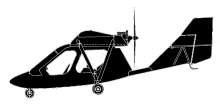
ASN Wikibase Occurrence # 301049
This information is added by users of ASN. Neither ASN nor the Flight Safety Foundation are responsible for the completeness or correctness of this information.
If you feel this information is incomplete or incorrect, you can submit corrected information.
| Date: | Sunday 21 December 1997 |
| Time: | 15:15 |
| Type: |  Quicksilver GT-500 |
| Owner/operator: | private |
| Registration: | UNREG |
| MSN: | |
| Fatalities: | Fatalities: 0 / Occupants: 2 |
| Aircraft damage: | Substantial |
| Category: | Accident |
| Location: | near Bat Cave Field Airport, San Antonio, Texas -
 United States of America United States of America
|
| Phase: | En route |
| Nature: | Training |
| Departure airport: | San Antonio-Kitty Hawk Ultralight Field, Texas |
| San Antonio-Kitty Hawk Ultralight Field, Texas | |
| Investigating agency: | NTSB |
| Confidence Rating: |
During cruise flight, the left leading edge wing strut fitting failed, & the amateur-built aircraft, which was being operated as an ultralight vehicle under an exemption to Title 14 CFR Part 103, entered a left spin. The ultralight instructor pilot deployed the aircraft's emergency parachute, which inflated partially & slowed the aircraft's rate of descent. A witness observed the aircraft impact the ground in a nose down attitude at an estimated speed of 25 to 30 mph.
Examination revealed the wing strut fitting failed due to improper installation of the 3 bolts, used to secure the fitting to the leading edge wing spar. The bolts had been inserted through the forward holes of the fitting, through holes in the tubular spar, but not through the rear holes of the fitting. This defect was not visible during preflight inspections; however, it could have been found during a condition inspection, since a zipper installed in the fabric lower wing surface provided access to examine the rear of the fitting with the aid of a flashlight & mirror.
No record was found to indicate that a condition inspection had been performed on the kit-built aircraft, in accordance with provisions for using the '2-Place Training Exemption.' The aircraft was first flown in February 1995 & had been owned by the pilot since June 1995. The main line, which fastened the Ballistic Recovery System (BRS) parachute to the airplane, was found wrapped around the propeller drive shaft of the rear-mounted (pusher) engine.
Probable Cause and Findings
the kitplane builder's improper installation of the bolts attaching the left leading edge wing strut fitting to the leading edge spar, which resulted in the eventual failure of the fitting and the ensuing loss of control. Related factors were: the owner/pilot's failure to ensure that a condition inspection of the aircraft was performed, and failure of the aircraft's emergency (Ballistic Recovery System) parachute to fully deploy.
Accident investigation:
 |
|
Sources:
NTSB
Revision history:
| Date/time | Contributor | Updates |
|---|---|---|
| 12-Nov-2022 20:00 | harro | Added |
| 13-Nov-2022 13:21 | harro | Updated [Date] |
Corrections or additions? ... Edit this accident description
The Aviation Safety Network is an exclusive service provided by:


 ©2024 Flight Safety Foundation
©2024 Flight Safety Foundation